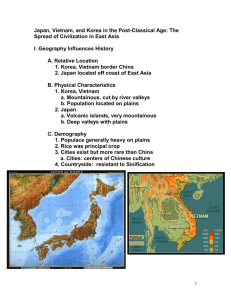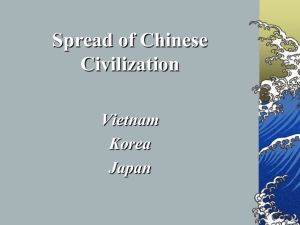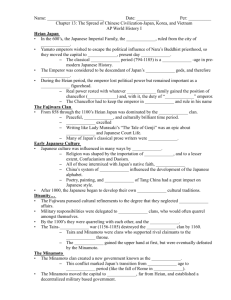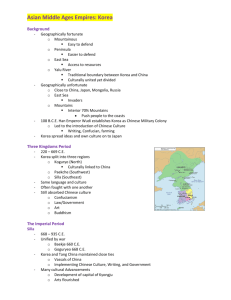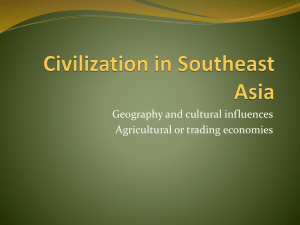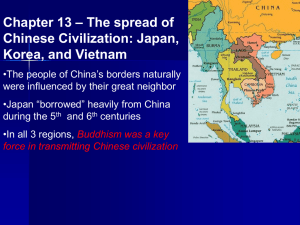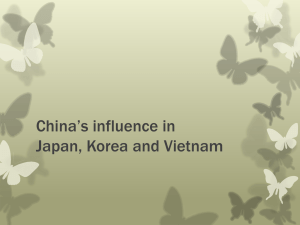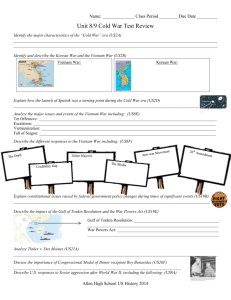File
advertisement
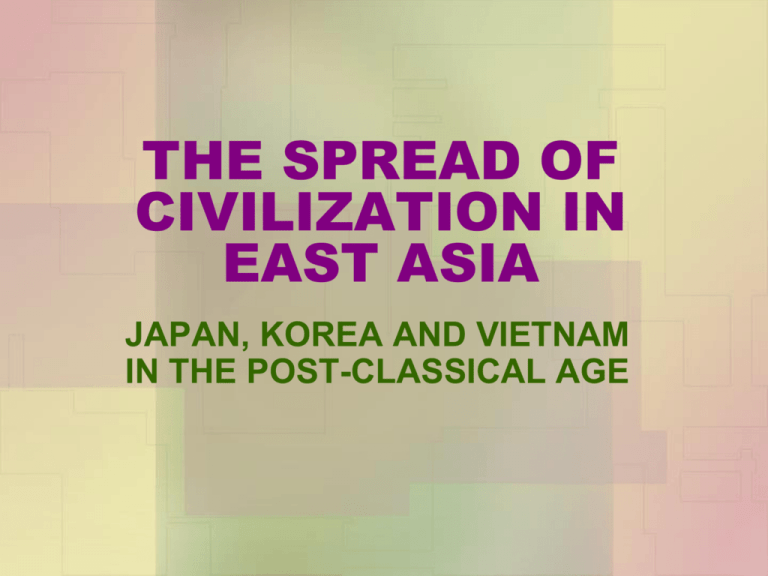
THE SPREAD OF CIVILIZATION IN EAST ASIA JAPAN, KOREA AND VIETNAM IN THE POST-CLASSICAL AGE GEOGRAPHY INFLUENCES HISTORY • Relative Location – Korea, Vietnam border China – Japan located off coast of East Asia • Physical Characteristics – Korea, Vietnam • Mountainous, cut by river valleys • Population located on plains – Japan • Volcanic islands, very mountainous • Deep valleys with plains • Demography – Populace generally heavy on plains – Rice was principal crop – Cities exist but rarer than China • Cities: centers of Chinese culture • Countryside: resistant to Sinification THE CONFUCIAN WORLD Sinification of Japan, Korea and Vietnam Himeji Castle, Japan Overview of Sinification • Two ways Chinese influence entered Japan, Korea and Vietnam: 1) Peacefully thru Buddhist missionaries. 2) By force. 2 kinds of force: • 1) J,K & V gov’t orders and 2) Chinese attack (on Vietnam) • Peaceful Sinification tended to “stick”. • Forced Sinification tended not to. • Huge exception: Chinese written language was “forced” on J, K and V by their leaders. (In the 18th c., French Catholic missionaries introduced a new Latin-based alphabet to Vietnam, which is used today). Japanese Korean Korea to 1400 • Korea in the Ancient and Classical Periods – Influenced by developments in China – Chinese armies invaded periodically – Chinese established control of parts of Korea – Nomadic invasions frequent – Fall of Han left regional Korean aristocrats in control • Korean History 669 – 1392 C.E. – Tang armies conquered much of Korea • Silla dynasty allied with Tang, ruled peninsula • Entered into a tributary relationship with China – Song replaced Tang • Koguryo conquered Silla in 935, ruled to 1392 Korea and China • China's influence in Korea – Sinification = becoming Chinese – Koreans borrowed what was useful, unavoidable; avoided what was not – Tributary embassies included Korean royal officials and scholars – Silla kings built new capital at Kumsong modeled on the Tang capital • Older Traditions – Ancestor worship strong in Korean society – Korean officials trained in Confucian ideas during Han, Tang but not as strong • Newer Traditions – Korean elite turned to Neo-Confucianism – Peasants turned to Chan Buddhism • Difference from China: aristocracy and royal houses dominated Korea Korean Palace Detail • Sinification anyone? Vietnam Maps Vietnam through 1400 • Nam Viet people originated in Southern China – Rise of Han and southern settlement of Chinese pushed Viet out – Viet migrated into Red River Valley, down coast fighting local inhabitants • Vietnam under Chinese rule to c. 983 CE – Han first conquered Northern Vietnam in 111 BCE • Viet elites adopted Chinese agriculture, schools, thought; intermarried • Massive migration of Chinese officials, scholars, bureaucrats to Vietnam – Trung sisters led revolt against Chinese rule (40 – 43 CE) • Peasants resented Chinese influence, role of towns, cities • 1,000 year struggle for independence • Relationship often tributary to China • Independent Vietnam (c. 983 CE) – Ruled by Dynasties, capital moved between Hanoi, Hue – Constant pressure against hill peoples, pushing south Hue Palace, Vietnam Vietnam vs. China • Difference from China – Role of village equal to role of family in China – Few cities; villages dominate countryside, elders ran villages – Many Vietnamese retained their religious traditions – Women played more prominent roles in Vietnam • Could be head of households, own land, engage openly in business • Were often leaders of villages and even at national level • Chinese influence in Vietnam limited to the elite • Elites adopted bureaucracy, form of state, emperorship, Confucianism • Adopted Chinese script, literary and artistic models • Mahayana Buddhism (although region is Theravada) also arrived • Irrigation and water control techniques • Ancient Japan Early Japan – Earliest inhabitants were nomadic Caucasians (Ainu) from Northeast Asia – Japanese related to Koreans, migrated into islands, pushed Ainu north • Ruled by several dozen states dominate by clans, 1st millennium BCE • Shinto: Ancestor veneration with deification of nature, spirits (kami) • Nara Japan (710-794 C.E.) – Inspired by Tang, Yamato clan claimed imperial authority • The imperial court modeled on that of the Tang • Built a new capital (Nara) in 710 C.E., modeled on Chang'an • Prince Shotoku wrote first Japanese constitution – Adopted Confucianism and Buddhism, but maintained Shinto Heian Japan • Heian Japan (794-1185 C.E.) – Moved to new capital Heian (modern Kyoto) in 794 – Japanese emperors as ceremonial figureheads and symbols of authority • • • • Effective power in the hands of the Fujiwara family Emperor did not rule Lived in splendid isolation along with court elite Effected by bureaucrats, complex etiquette – Chinese learning dominated Japanese education, culture • The Tale of Genji • Women contributed most to Japanese literature and writing • Decline of Heian Japan – Equal-field system began to fail – Aristocratic clans accumulated lands • Rivalry between court nobility and landed aristocracy • Taira and Minamoto, the two most powerful clans, engaged in wars • The clan leader of the victorious Minamoto claimed the title of shogun Life in the Heian Palace Heian Palace Complex Japan Maps Medieval Japan • Japanese feudalism – Called the Shogunate Period • Military dictators ruled, Emperors reigned in splendid isolation • Government was centralized feudalism – Countryside divided up into fiefs – Daimyo appointed by the shoguns – Adopted Neo-Confucianism as state philosophy • Provincial lords controlled Japan – Called Daimyo, vied for power against each other – Constant war to increase personal power, wealth, fiefs – Kamakura Period (1185-1333 C.E.) – Muromachi Period (1336-1573 C.E.) • The Samurai – The lowest class of aristocratic nobility • Professional warriors of provincial lords • Observed samurai code called bushido • Valued loyalty, military talent, and discipline; traded military skills for food • To preserve their honor, engaged in ritual suicide called seppuku Women in Japan • Japanese Women – Legendary founder of Japan, Yamato clan was sun goddess, Amaterasu – Under Heian • They were the cultural elite with elaborate rituals including dress • Had great influence, including several empresses – Under Shogunate • Lost considerable influence as Neo-Confucianism introduced, warfare spread • Could still be samurai and fight but patriarchal society • Shinto was also male dominated and included ancestor worship FIEFS OF FEUDAL JAPAN
